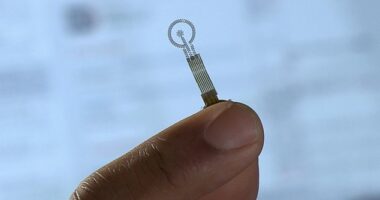THE BASE of the 28-mile-wide Jezero crater on Mars is what remains of an ancient lake, scientists have confirmed in a new study.
Sediment collected from the bottom of the eons-old lake will act as an important “puzzle piece” in the hunt for alien life on the Red Planet, lead author of the study Dr David Paige told The Sun.
Scientists used the Perseverance rover’s Radar Imager for Mars’ Subsurface Experiment, or RIMFAX, tool to see old lake sediment roughly 20metres below the surface of the crater floor.
Years of research with ground-penetrating radar and testing of RIMFAX on Earth have taught scientists how to ‘see’ subsurface layers from their radar reflections.
Over the eons, the Jezero lake shrank and sediments carried by the river that fed it formed an enormous delta.
Once the sediments in the crater were eroded, the geologic features that are visible on the Martian surface today were formed.
READ MORE ON SPACE
The lake implies the existence of an ancient “plumbing system” on Mars, according to Dr Paige, who added: “That’s exciting for signs of life.”
The findings are a result of a decade of work.
“The rover’s been there ever since march of 2021… but of course the effort to get the data and build the instrument went a bit further back so realistically ten years in making,” said Dr Paige.
The rover, which is about the size of a car and carries seven different scientific tool onboard, has been exploring the Jezero crater, studying its geology and atmosphere and collecting samples since 2021.
Most read in Tech
Perseverance’s soil and rock samples will be brought back to Earth studied for evidence of past life in a future expedition.
Of all the craters on Mars, why choose Jezero?

Mars is blanketed with tends of thousands of craters – mostly caused by impact.
But scientists have outlined 205 craters that could have been closed-basin lakes several billion years ago.
Of all the craters on Mars, why did researchers behind the Perseverance rover choose Jezero?
“We don’t know where the real goodies are going to be,” Dr Paige explained.
“There were a hole series of landing sites that were considered.”
The deciding factors that pushed scientists towards Jezero were: engineering constraints such as poor terrain, altitude, and how close to the equator it is.
The Jezero Crater is just north of the Martian equator, where temperatures are closer to -55C than the -153C you can experience at the poles.
In 2022, Perseverance drove from the crater floor onto the delta, a vast expanse of 3 billion-year-old sediments that, resembles the river deltas on Earth from an orbital perspective.
Scientists also discovered that a second period of deposition occurred when fluctuations in the lake level allowed the river to deposit a broad delta that once extended far out into the lake.
It has now eroded back closer to the river’s mouth.
“The thing about geology in general is that it’s not really linear in time, in other words, we have these little windows of opportunity where we have a record that is preserved,” said Dr Paige.
What makes Mars particularly interesting is that there has been little erosion or tectonic movement in recent history – unlike earth where much has been erased.
“The history is preserved,” Dr Paige explains, “just laying there for us to look at. It makes it very different to that of Earth.”
“The main focus of the mission is to return these samples back to Earth, that will involve many missions.
“This is saying ok, the samples we’re able to get might be kind of interesting.
“They definitely formed in this lake-like environment, where on Earth, at least, has always been crawling with life.
READ MORE SUN STORIES
“But your mileage may vary, sometimes you’ll find fossil and sometimes you wont.
“It’s just one piece of the puzzle.”
Find out more about science
Want to know more about the weird and wonderful world of science? From the Moon to the human body, we have you covered…










